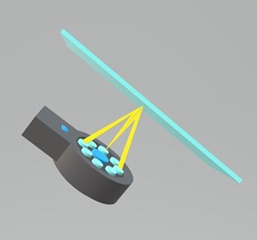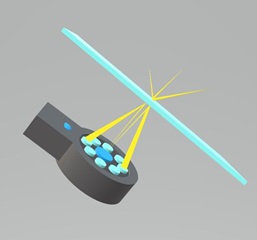Along with the camera and the fog sensor, the rain light sensor (RLS) is one of the most common sensors fitted in today's windscreens. We'll take a closer look at how it works today.
The jobs of the RLS include the automatic switching on or off of the headlights, day and night detections, and the activation of the windscreen wipers.
Also, the RLS provides the ABS/ESP with information on whether the road is wet or dry. In vehicles with traffic sign recognition, the RLS supports the display of any signs relating to wet roads, depending on the equipment.
Fig. 2: Sensor function on a dry windscreen

Fig. 1: Structure of rain sensor
1 - Apron light sensor
2- Light diode rain sensor
3- Photodiode rain sensor / global field sensor
The rain sensor works on the principle of light refraction. It consists of several light-emitting diodes and a photodiode. When the windscreen is dry, the emitted light (shown in yellow) is almost completely reflected and detected by the photodiode.
Fig. 3: Sensor function on a wet windscreen

If there are rain drops in the area of the rain sensor, a part of the emitted light is refracted away. As a result, the photodiode only sees a small part of the light that was emitted. If very little light gets back to the sensor this means that the windscreen is very wet. So, it can tell how heavy the rain is.
The light emitting diodes emit light in the infrared range using a band filter. After replacing a windscreen, it may be necessary to reinitialise the RLS. If the old windscreen was scratched or worn, the RLS will have adapted. Reinitialising the RLS will reset the learning system so it can adapt to the new windscreen.
The light sensor has a simple design. It consists of two independent light receivers: The global field area and the fore-field area. These two areas are necessary for detecting environmental conditions such as tunnel entrances or tree lined roads.
The global field sensor measures the light intensity immediately around the vehicle. The fore-field sensor measures the light intensity in the nearby road area. If both field sensors report "dark" at the same time, the low beam is switched on. If both field sensors report light/dark alternating with each other, the vehicle is probably on a road with changing light conditions. In this case, the low beam is not switched on because the overall brightness is high enough on average.
In many Volkswagen & Audi Group (VAG) vehicles, the global field sensor function is already integrated into the photodiode of the rain sensor. At VAG, the rain light sensor is mostly a LIN bus participant and declared as a so-called 'servant'. The vehicle electrical system control unit is connected to the rain light sensor and acts as a 'master'. A master control unit can manage up to 16 LIN servant units. The master control unit actively requests data from the rain light sensor which responds to the demand. The master control unit then makes this data available to the CAN network.
When replacing a windscreen, it is essential to ensure that no large air bubbles remain between the sensor and the windscreen. If air bubbles appear during replacement, you should massage or brush them out. Smaller air bubbles will escape after one or two days as soon as pressure is applied to the sensor by the retaining clip.
I recommend that you always replace the gel pad on older vehicles. Safety First! There are prefabricated sensor saver pads that can be easily and directly fitted.
Don't your wipers work? It's possible that the information is not reaching the wiper motor because the LIN or CAN network has a problem. In this case, you will need to read out the fault memory.
Has a windscreen been installed with a differently coloured band filter? Make sure that the control unit allows a different basic setting for the corresponding colour.
Do malfunctions occur after replacement? If the old windscreen was heavily scratched, try resetting the learning values of the rain light sensor using a diagnostic tester.